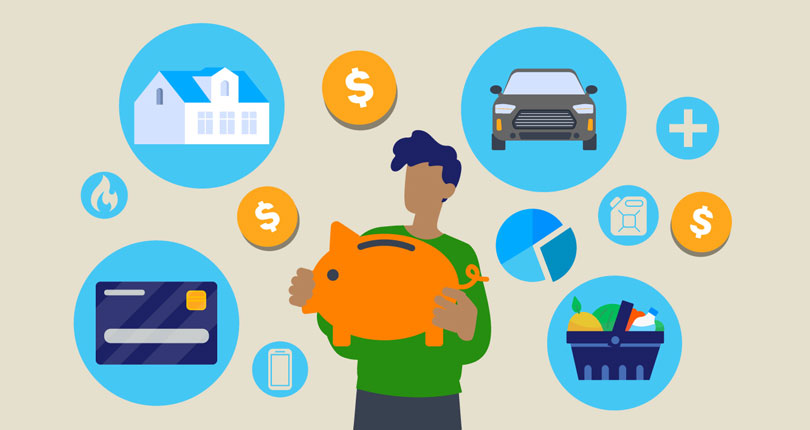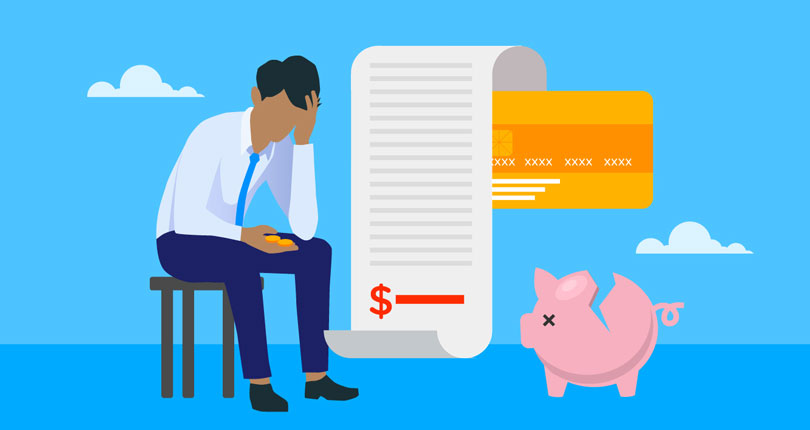Student Loan Debt Statistics

If you’ve been to college recently or you’re a parent of someone who has, you’ll know that getting a degree involves a considerable financial sacrifice. The cost of a college education is on the rise, and 43.6 million American adults currently have student loan debt. [1] Hanson, Melanie. “Student Loan Debt Statistics” EducationData.org, August 20, 2023 https://educationdata.org/student-loan-debt-statistics
We’ve broken down some of the key student loan debt statistics to give you an insight into the change over time, and how families are dealing with the increase.
Key statistics
- The total amount of student loan debt in the U.S. stands at $1.77 trillion as of 2023.
- In 2023, the average student debt per person was $37,650 at graduation.
- People aged 25-34 are the most likely to have student loan debt, with 15 million borrowers in this age group.
- Maryland had the highest average student debt in 2023, at $42,280 per graduate, North Dakota had the lowest, with $28,921.
- People of color and women are the most likely groups to have student loan debt. A quarter (24%) of Black adults have federal student loan debt compared to 14% of white adults.
- Women hold 66% of all student loan debt, compared to 34% for men.
- By 2030, the average graduate student debt amount could reach $50,000.
Total student debt per year
Since 2008, the total amount of student debt in the U.S. has risen by over $1 trillion, with a staggering 160% increase from 2008 to 2023.
The total student loan debt amount in the U.S. now stands at $1.77 trillion, compared with $0.68 trillion in 2008.
| Year | Total Student Debt in the U.S. ($ trillions) |
|---|---|
| 2008 | $0.68 |
| 2009 | $0.77 |
| 2010 | $0.86 |
| 2011 | $0.96 |
| 2012 | $1.05 |
| 2013 | $1.15 |
| 2014 | $1.24 |
| 2015 | $1.32 |
| 2016 | $1.41 |
| 2017 | $1.49 |
| 2018 | $1.57 |
| 2019 | $1.64 |
| 2020 | $1.69 |
| 2021 | $1.73 |
| 2022 | $1.76 |
| 2023 | $1.77 |
Source [1] Hanson, Melanie. “Student Loan Debt Statistics” EducationData.org, August 20, 2023 https://educationdata.org/student-loan-debt-statistics
The steep increase in total student debt over time can mainly be attributed to the increase in the cost of tuition. The average cost of private college tuition has increased from $28,452 in 2010 to $46,652 in 2024. [3] Tuition Growth https://www.usnews.com/education/best-colleges/paying-for-college/articles/2017-09-20/see-20-years-of-tuition-growth-at-national-universities This shows a 63.9% increase in the average cost of tuition during that time, so it’s no surprise that the total student debt has also seen an upward trend.
Estimated projection of student loan debt
Using the upward trend of student loan debt between 2008 and 2023, we can estimate that student loan debt will surpass $2 trillion by 2025 and could hit $2.2 trillion in 2027.
| Year | Student Debt | Predicted |
|---|---|---|
| 2008 | $0.68 | |
| 2009 | $0.77 | |
| 2010 | $0.86 | |
| 2011 | $0.96 | |
| 2012 | $1.05 | |
| 2013 | $1.15 | |
| 2014 | $1.24 | |
| 2015 | $1.32 | |
| 2016 | $1.41 | |
| 2017 | $1.49 | |
| 2018 | $1.57 | |
| 2019 | $1.64 | |
| 2020 | $1.69 | |
| 2021 | $1.73 | |
| 2022 | $1.76 | |
| 2023 | $1.77 | |
| 2024 | $1.97 | |
| 2025 | $2.05 | |
| 2026 | $2.13 | |
| 2027 | $2.20 |
Data note: The growth of total student loan debt slowed between 2021 and 2023 due to a reduction in college enrollments during the COVID-19 pandemic. The predicted figures have been calculated using the trend from 2008 to 2023 which assumes college enrolments returning to pre-COVID levels. [11] National Student Clearinghouse Research Center, Current Term Enrollment Estimates https://nscresearchcenter.org/current-term-enrollment-estimates/
Average federal student debt per person
The average amount of federal student debt per person in the U.S. has been climbing steadily for a number of years. With the increase in average college tuition typically rising year over year, debt per student follows the same trend.
The chart below shows the increase since 2007 in cash terms and when adjusted for 2023 inflation. The average federal student debt per person has increased by 40.9% during this period when using inflation-adjusted figures, and by 106.5% without adjusting for inflation. We have also estimated a prediction of the average student debt until 2034 using the current trend. This shows that by 2030, the average student debt amount per student could reach over $50,000.
| Year | Avg Federal Student Debt Per Person | Avg Federal Student Debt Per Person (inflation adjusted) | Predicted |
|---|---|---|---|
| 2007 | $18,230.00 | $26,720.00 | |
| 2008 | $19,300.00 | $28,250.00 | |
| 2009 | $20,470.00 | $29,170.00 | |
| 2010 | $21,860.00 | $30,700.00 | |
| 2011 | $23,240.00 | $31,690.00 | |
| 2012 | $24,760.00 | $33,190.00 | |
| 2013 | $26,270.00 | $34,690.00 | |
| 2014 | $27,760.00 | $36,390.00 | |
| 2015 | $29,140.00 | $37,920.00 | |
| 2016 | $30,550.00 | $38,940.00 | |
| 2017 | $32,090.00 | $40,060.00 | |
| 2018 | $33,550.00 | $41,100.00 | |
| 2019 | $35,210.00 | $42,170.00 | |
| 2020 | $36,510.00 | $43,140.00 | |
| 2021 | $37,110.00 | $40,970.00 | |
| 2022 | $37,570.00 | $38,970.00 | |
| 2023 | $37,650.00 | $37,650.00 | |
| 2024 | $41,911 | ||
| 2025 | $43,328 | ||
| 2026 | $44,746 | ||
| 2027 | $46,163 | ||
| 2028 | $47,581 | ||
| 2029 | $48,998 | ||
| 2030 | $50,416 | ||
| 2031 | $51,833 | ||
| 2032 | $53,250 | ||
| 2033 | $54,668 | ||
| 2034 | $56,085 |
Source [2] Hanson, Melanie. “Average Student Loan Debt by Year” EducationData.org, October 25, 2023 https://educationdata.org/average-student-loan-debt-by-year

How to Build Credit When You Have None
Building credit from scratch can be a lot easier when you understand where to start and which mistakes to avoid.
Download our guideAverage student debt by state
Average student debt varies slightly from state to state. In 2023, Maryland had the highest average student loan debt at $42,280. North Dakota had the lowest average student loan debt in 2023 at $28,921.
Below is a breakdown of the average student debt by state as of September 2023.
| State | Average federal student loan debt per person (2023) |
|---|---|
| Alabama | $36,589 |
| Alaska | $34,884 |
| Arizona | $34,683 |
| Arkansas | $32,852 |
| California | $36,891 |
| Colorado | $36,364 |
| Connecticut | $35,397 |
| Delaware | $37,341 |
| Florida | $38,065 |
| Georgia | $40,804 |
| Hawaii | $36,918 |
| Idaho | $32,403 |
| Illinois | $37,644 |
| Indiana | $32,209 |
| Iowa | $29,943 |
| Kansas | $32,158 |
| Kentucky | $32,610 |
| Louisiana | $33,731 |
| Maine | $33,578 |
| Maryland | $42,280 |
| Massachusetts | $34,427 |
| Michigan | $35,790 |
| Minnesota | $33,346 |
| Mississippi | $36,201 |
| Missouri | $34,668 |
| Montana | $33,153 |
| Nebraska | $31,337 |
| Nevada | $33,711 |
| New Hampshire | $33,881 |
| New Jersey | $35,934 |
| New Mexico | $33,493 |
| New York | $37,434 |
| North Carolina | $37,485 |
| North Dakota | $28,921 |
| Ohio | $34,025 |
| Oklahoma | $31,182 |
| Oregon | $36,989 |
| Pennsylvania | $35,096 |
| Rhode Island | $29,997 |
| South Carolina | $32,323 |
| South Dakota | $37,551 |
| Tennessee | $29,975 |
| Texas | $35,790 |
| Utah | $32,717 |
| Vermont | $32,751 |
| Virginia | $36,990 |
| Washington | $38,900 |
| West Virginia | $35,611 |
| Wisconsin | $31,264 |
| Wyoming | $31,679 |
Source [4] Student Aid https://studentaid.gov/data-center/student/portfolio
Student loan debts by demographic
There are currently around 43.6 million adults in the U.S. with federal student loan debt. Let’s take a look at how those borrowers break down into different demographics.
Student debt by age
When we look at the age breakdown of federal student loan borrowers, the 25-34 age group had the most student debt as of 2023. With 33.4% of the total student loan debt, this age group included 15.1 million total borrowers.
Unsurprisingly, the age group with the fewest student loan borrowers was 62 and over, with 2.7 million people and just 4.7% of the total borrowers. People over the age of 50 who went to college between the 1960s and 1990s are likely to have borrowed much less than today’s college students, and have spent their working lives paying off what they did borrow.
| Age (2023) | Number of People With Federal Student Loan Debt |
|---|---|
| 18-24 | 7.1 million |
| 25-34 | 15 million |
| 35-49 | 14.6 million |
| 50-61 | 6.3 million |
| 62 and over | 2.7 million |
Source [4] Student Aid https://studentaid.gov/data-center/student/portfolio
Almost one in four (23%) millennials have student loan debt compared with 18% of Gen Z, 17% of Gen X and 7% of baby boomers. Women aged 18-44 are the most likely to have student debt (27%) compared with 15% of men in the same age group. [5] CNBC Momentive Poll https://www.surveymonkey.com/curiosity/cnbc-invest-in-you-jan-2022/
Student debt by gender
Student debt data by gender shows that there are more women in the U.S. with student loan debt than men. 66% of all student debt belongs to women, while 34% belongs to men.
Recent estimates for 2022 suggest that 25 million women in the U.S. have student loan debt, compared to around 18 million men in the U.S. Once they graduate from college, women are likely to earn less than men according to research by the U.S. Census Bureau, meaning they stay in debt longer and incur more interest over time.
| Gender (2022) | % of student loan debt |
|---|---|
| Women | 66% |
| Men | 34% |
Source [6] Hanson, Melanie. “Student Loan Debt by Gender” EducationData.org, July 16, 2023 https://educationdata.org/student-loan-debt-by-gender
At this time, there is not enough data about student debt in the non-binary and trans communities to draw meaningful insight due to the low relative population. The data that is available suggests that gender-variant students face policy-related issues including identity verification which may create obstacles for them when applying for student loans.
Available statistics also show that the average gender minority student borrows around 10% more than non-gender minority students. [6] Hanson, Melanie. “Student Loan Debt by Gender” EducationData.org, July 16, 2023 https://educationdata.org/student-loan-debt-by-gender
Student debt by race
Comparing student loan statistics by race shows that people of color are more likely to have student debts than white people. This, along with the higher proportion of women having student loan debt, tends to reflect historical access to capital.
According to a CNBC/SurveyMonkey poll of 5,162 from 2022, 24% of Black adults say they have federal student loan debt, compared to 15% of Hispanics, 14% of white people, and 11% of Asians. [5] CNBC Momentive Poll https://www.surveymonkey.com/curiosity/cnbc-invest-in-you-jan-2022/
How many Americans have student loan debt?
43.6 million Americans currently have federal student loan debt in the U.S. This equates to about 13% of the country’s population based on 2022 census figures. According to the Federal Reserve, approximately 30% of people who went to college took out some form of loan in order to attend.
The figure has increased by almost 10 million since 2010 when there were 34 million Americans with student loan debt. The graph below shows the change from 2010 to 2022.
| Year | Number of U.S. Population with Federal Student Loan Debt (millions) |
|---|---|
| 2010 | 34.3 |
| 2011 | 36.5 |
| 2012 | 38.3 |
| 2013 | 39.6 |
| 2014 | 40.7 |
| 2015 | 41.6 |
| 2016 | 42.3 |
| 2017 | 42.6 |
| 2018 | 42.9 |
| 2019 | 42.9 |
| 2020 | 42.3 |
| 2021 | 43 |
| 2022 | 43.6 |
Source [1] Hanson, Melanie. “Student Loan Debt Statistics” EducationData.org, August 20, 2023 https://educationdata.org/student-loan-debt-statistics
Undergraduate debt vs postgraduate debt
When looking at the difference between undergraduate and postgraduate debt, we can see that most student borrowers (94.8%) took out loans for undergraduate studies. 44.2% used a student loan to fund their postgraduate education.
| % of all student loan borrowers who borrowed for each type of education | |
|---|---|
| Undergraduate | 94.8 |
| Postgraduate | 44.2 |
Source [1] Hanson, Melanie. “Student Loan Debt Statistics” EducationData.org, August 20, 2023 https://educationdata.org/student-loan-debt-statistics
Paying off student loans
When it comes to paying off student loans, your salary, amount of debt, and interest rates all affect how much you’ll pay per month and how long it’ll take you to pay your debt off in full.
How long does it take to pay off a student loan?
The chart below shows us how long it would take on average to pay back student loans for Associate’s, Bachelor’s, Master’s and Doctoral degrees and different types of colleges. Paying back a loan for a doctoral degree from a private for-profit college takes by far the longest at 459 months (or 38 years and 3 months).
| Public College | Private College (weighted average) | Private (Non-Profit) | Private (For-Profit) | |
|---|---|---|---|---|
| Associate's | 27 | 38 | 37 | 39 |
| Bachelor's | 65 | 73 | 70 | 86 |
| Master's | 98 | 158 | 147 | 220 |
| Doctoral | 152 | - | 157 | - |
Source [7] Hanson, Melanie. “Average Time to Repay Student Loans” EducationData.org, September 25, 2023 https://educationdata.org/average-time-to-repay-student-loans
Data note: This chart shows student loan repayment timelines from source [7]. The figure for 'private college (weighted average)’ has been calculated using the private non-profit and private for-profit figures and takes into account the higher enrollment in private non-profit schools to create a weighted average.
The average monthly student loan payment
Unsurprisingly, the mean monthly repayment for a Doctoral degree loan was also the highest, at $1,210 per month.
| Average Monthly Student Loan Payment | Low End Salary | High End Salary | Mean Monthly Repayment |
| Associate's | $305 | $566 | $436 |
| Bachelor's | $434 | $807 | $621 |
| Master's | $504 | $936 | $720 |
| Doctoral | $610 | $1,173 | $903 |
| Professional | $631 | $1,172 | $901 |
Source [7] Hanson, Melanie. “Average Time to Repay Student Loans” EducationData.org, September 25, 2023 https://educationdata.org/average-time-to-repay-student-loans
Latest interest rates on federal student loans
| Loan Type | Interest Rate (%) as of April 2023 | |
|---|---|---|
| Undergraduate | Direct | 4.99% |
| Graduate & Professional | Direct | 6.54% |
| Parent, Graduate & Professional | PLUS | 7.54% |
Source [8] Hanson, Melanie. “Average Student Loan Interest Rate” EducationData.org, April 29, 2023 https://educationdata.org/average-student-loan-interest-rate
A recent study on behalf of Self on the life of interest payments found that using a federal interest rate of 6%, students paid an average of $20,803 in student loan interest over 20 years.
Student loan forgiveness statistics
Data from the U.S. Department of Education shows that between November 2020 and June 2023, only 3.3% of applications for Public Service Loan Forgiveness (PSLF) have been accepted.
From October 2021 to October 2022, the U.S. Department of Education implemented a change to PSLF as a result of the COVID-19 national emergency. Data as of July 2023 shows that 662,000 borrowers have qualified for loan forgiveness under this limited PSLF waiver. [9] Student Loan Forgiveness https://studentaid.gov/data-center/student/loan-forgiveness/pslf-data
How do you get student loans forgiven?
Many students and graduates with loan debt wonder if it’s possible to have their student loans forgiven or to get some help with paying them back. There are a few options available when it comes to student loan forgiveness. There are specific criteria you’ll need to meet in order to qualify, but let’s take a look at some of the options. [10] Student Loan Forgiveness (and Other Ways the Government Can Help You Repay Your Loans) https://studentaid.gov/articles/student-loan-forgiveness/
- Teacher loan forgiveness - Teachers who teach full time for five consecutive years at elementary or secondary schools or educational service agencies for low-income families can qualify for loan forgiveness. You’ll need to meet specific qualifications but you may be eligible for $17,500 of forgiveness on your loan.
- Income driven repayment plan (IDR) - You can repay your loans through a repayment plan based on your income, and any balance left on your student loan will be forgiven after a certain amount of time after you make a specified number of payments.
- Public service loan forgiveness (PSLF) - You might qualify for forgiveness on your remaining student loans if you work full-time for a non-profit or government organization. You’ll be eligible after you’ve made 120 payments (or 10 years' worth of payments).
- AmeriCorps - People who complete a term of national service through an approved AmeriCorps program will be eligible to receive a Segal AmeriCorps Education Award which can be used to pay off remaining student loans that qualify.
- Military service - The U.S. Department of Education and U.S. Department of Defense offer special repayment options on student loans for people who serve in the U.S. Military. These include loan repayment programs and caps on interest rates.
Sources
- [1] Hanson, Melanie. “Student Loan Debt Statistics” EducationData.org, August 20, 2023 https://educationdata.org/student-loan-debt-statistics
- [2] Hanson, Melanie. “Average Student Loan Debt by Year” EducationData.org, October 25, 2023 https://educationdata.org/average-student-loan-debt-by-year
- [3] Tuition Growth https://www.usnews.com/education/best-colleges/paying-for-college/articles/2017-09-20/see-20-years-of-tuition-growth-at-national-universities
- [4] Student Aid https://studentaid.gov/data-center/student/portfolio
- [5] CNBC Momentive Poll https://www.surveymonkey.com/curiosity/cnbc-invest-in-you-jan-2022/
- [6] Hanson, Melanie. “Student Loan Debt by Gender” EducationData.org, July 16, 2023 https://educationdata.org/student-loan-debt-by-gender
- [7] Hanson, Melanie. “Average Time to Repay Student Loans” EducationData.org, September 25, 2023 https://educationdata.org/average-time-to-repay-student-loans
- [8] Hanson, Melanie. “Average Student Loan Interest Rate” EducationData.org, April 29, 2023 https://educationdata.org/average-student-loan-interest-rate
- [9] Student Loan Forgiveness https://studentaid.gov/data-center/student/loan-forgiveness/pslf-data
- [10] Student Loan Forgiveness (and Other Ways the Government Can Help You Repay Your Loans) https://studentaid.gov/articles/student-loan-forgiveness/
- [11] National Student Clearinghouse Research Center, Current Term Enrollment Estimates https://nscresearchcenter.org/current-term-enrollment-estimates/





